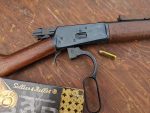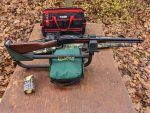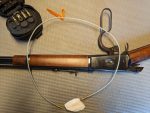Inspired by John Moses Browning’s iconic Winchester Model 1892, the Heritage 92 comes in a number of different models with various barrel lengths, finishes, and chamberings. The version that I tested has a 20 inch barrel, is chambered in .44 Magnum, holds 10 rounds in the tubular magazine, has semi-buckhorn sights, and walnut-colored tropical hardwood furniture.
The Heritage 92 is light, attractive, and well-machined, operates reliably, and puts the shooter in touch with his inner movie cowboy. The .44 Magnum chambering has enough energy and a flat enough trajectory from a rifle length barrel to make the Heritage 92 useful for medium-sized game out beyond 100 yards. By about 150 yards or so, bullet drop begins to become a significant enough factor to make accuracy more difficult.
At the time of this writing, the rifle had a manufacturer-suggested retail price of $863.99. It is made in Brazil by Companhia Brasileira de Cartuchos (Brazilian Cartridge Company).
If the foregoing description sounds attractive to you, you may want to give the Heritage 92 a closer look.
Background
Beginning in 1971, the then-young Clint Eastwood portrayed San Francisco Police Inspector “Dirty” Harry Callahan in a series of five films. Dirty Harry carried a Smith and Wesson Model 29 revolver chambered in .44 Magnum.
I am not Dirty Harry. I don’t want a handgun so powerful that it leaves me taking inventory of my body parts every time I fire it. But if I lived in grizzly country, I might feel differently. As a rifle chambering, on the other hand, .44 Magnum seems much more interesting. With greater weight and the presence of a stock, a rifle seems better suited to tame the power of the .44 Magnum cartridge than a handgun. So when Heritage Manufacturing Company offered to let me test their Heritage 92 in .44 Magnum, I did not even hesitate. I just quickly accepted their kind offer.
First Impressions
The rifle arrived generously oiled in a cardboard box. The box also contained a lead and hazardous chemical exposure warning card, a packing slip, a plastic bag containing the rifle, and a plastic bag containing a cable lock, NSSF Safe Storage brochure, NSSF brochure on the basics of safe gun handling, and the manual.
The finishes on the wood and on the metal parts are well done.
The semi-buckhorn iron rear sight harmonizes well with the Winchester Model 1892 aesthetic. There is no rail or tapped holes prepared for the installation of optics. The location of the ejection port on the top of the receiver would make a typical scope configuration somewhat problematic.
A manual safety on the top of the receiver improves on the original design.
A tag on the lever warns, “Keep the muzzle pointed in a safe direction. Keep your finger off trigger until ready to fire.” Although in general I oppose “Captain Obvious” warnings on product packaging, I make an exception in relation to gun safety. My general rationale is that if some guy is careless with a knife (for example) he may cut himself. If he is careless with a firearm, on the other hand, he may shoot someone else. I have seen enough people neglect the basic rules of firearms safety that I am in favor of reminding people as often as possible.
Highlights from the Manual
The manual is 28 pages long including the front and back covers. On the bottom of every page, the manual says, “Always keep the muzzle pointed in a safe direction and finger off the trigger.” Safety guidelines come at the front of the manual. As I mentioned above, I approve of these warnings. The manufacturer cannot assume that the buyer is an experienced and responsible firearm user.
There are a number of other items of note:
Heritagemfg.com has a helpful library of online videos related to firearms safety, use, and care.
The tradeoffs of safe storage are clearly expressed: “Securing your firearm may inhibit access in a defensive situation and may result in injury or death.” “Failure to secure a firearm may result in injury or death.”
They recommend against the use of reloaded ammunition. In fact, they object so strongly to the use of reloaded ammunition that its use voids the warranty.
The safety can be engaged when the hammer is at half cock or full cock, but not when it is at rest. The safety can be disengaged when the hammer is at rest or full cock but not at half cock.
The rifle can safely be decocked by slowly lowering the hammer with the safety engaged.
The rifle must only be loaded through the loading port.
They recommend only carrying the rifle with an empty chamber. It may fire if dropped or struck when the chamber is loaded.
In order to adjust for windage, the front sight must be drifted with a brass punch. The elevator on the rear sight can adjust for elevation.
They recommend waiting 30 seconds with the muzzle pointed in a safe direction in the event of a failure to fire in case of possible hang fire.
They recommend no disassembly prior to cleaning.
They recommend cleaning after every range session and after every 200 rounds fired during a range session.
There is a good exploded diagram and parts list.
The one-year limited warranty is valid for the original purchaser only.
Trigger Pull Weight
I tested the trigger using a Ready Up Gear Digital Trigger Pull Weight Gauge. A series of five test pulls resulted in weights ranging between 5.44 and 6.57 pounds, with an average of 5.79 and a median of 5.46 pounds.
At the Range
It was a somewhat grayish day in mid-November. A watery sun half-heartedly tried to brighten things up after a foggy morning. The temperature was 44 degrees Fahrenheit, serendipitously echoing the caliber of the rifle. A gentle breeze lazily stirred from the southeast from time to time. Half-sodden leaves carpeted the ground underfoot. Bare trees stretched toward the pewter-colored sky.
I set up a target stand in front of the backstop on the improvised range behind my pole barn. I then set up a table 25 yards away.
 I began by loading the tubular magazine. It readily accepted 11 rounds of Sellier & Bellot 240 grain SJHP even though the magazine is only rated to hold 10 rounds. I don’t know if I was inadvertently over-stressing the magazine spring, or if Heritage marketing was trying to make the rifle less scary for nanny-state politicians who think that anything that holds more than 10 rounds is a high-capacity magazine and some kind of modern innovation. Those politicians intentionally forget that already in 1892, the original Model 1892 held 12 rounds in its magazine. By the way, if you happen to own one of those pre-1899 antique rifles, they are not considered a “firearm” under Federal law in spite of their scary “high-capacity” magazines.
I began by loading the tubular magazine. It readily accepted 11 rounds of Sellier & Bellot 240 grain SJHP even though the magazine is only rated to hold 10 rounds. I don’t know if I was inadvertently over-stressing the magazine spring, or if Heritage marketing was trying to make the rifle less scary for nanny-state politicians who think that anything that holds more than 10 rounds is a high-capacity magazine and some kind of modern innovation. Those politicians intentionally forget that already in 1892, the original Model 1892 held 12 rounds in its magazine. By the way, if you happen to own one of those pre-1899 antique rifles, they are not considered a “firearm” under Federal law in spite of their scary “high-capacity” magazines.
 I chambered a round, and then placed the rifle on a Lead Sled on the table. I could not bore sight the rifle, so I fired a single round at the center target. It struck approximately three inches high and three inches to the left of the point of aim. If it had not involved a brass punch, I probably would have adjusted the front sight for windage. Since sight adjustment did involve a brass punch, I just left everything alone and fired two more rounds. Those first three shots grouped at one inch at 25 yards.
I chambered a round, and then placed the rifle on a Lead Sled on the table. I could not bore sight the rifle, so I fired a single round at the center target. It struck approximately three inches high and three inches to the left of the point of aim. If it had not involved a brass punch, I probably would have adjusted the front sight for windage. Since sight adjustment did involve a brass punch, I just left everything alone and fired two more rounds. Those first three shots grouped at one inch at 25 yards.
I then proceeded to fire three-shot groups at a number of other targets. With practice, I eventually managed to bring my group sizes down to 0.56 inches at 25 yards. That was not too bad for aging eyes with iron sights. While not exactly tack driving accuracy, the groups demonstrated more than sufficient practical accuracy for a rifle with a maximum effective range of about 150 yards or so.
I should note that I found the semi-buckhorn sights easier to acquire than I anticipated. A yellow dot on the front sight assisted with this process.
Next, I tried firing the rifle offhand. The rifle is light enough that the recoil of the .44 Magnum cartridge is noticeable if not uncomfortable. That is somewhat unusual for a pistol caliber carbine, but .44 Magnum is not your typical pistol caliber.
I am ashamed to admit that my offhand accuracy was poor: a six-inch three-shot-group at 25 yards. Whenever possible, I should fire braced against a tree, fire kneeling, or fire prone rather than offhand. Clint Eastwood said it best: “A man has got to know his limitations.”
Cleaning
 I used the Otis Tactical Gun Cleaning Kit to clean the rifle. The cable utilized by that system allowed me to clean from breech to muzzle rather than the muzzle-to-breech-cleaning that would have been necessary if I used a cleaning rod. I first drew several swabs through the bore using OGRE Manufacturing Enviroclean FA Gun Cleaner. I followed that with a bronze brush. I then drew a dry swab through the bore, followed by a swab with Breakfree CLP. I finished up by cleaning the other accessible metal parts in the receiver and exterior of the rifle in the same manner.
I used the Otis Tactical Gun Cleaning Kit to clean the rifle. The cable utilized by that system allowed me to clean from breech to muzzle rather than the muzzle-to-breech-cleaning that would have been necessary if I used a cleaning rod. I first drew several swabs through the bore using OGRE Manufacturing Enviroclean FA Gun Cleaner. I followed that with a bronze brush. I then drew a dry swab through the bore, followed by a swab with Breakfree CLP. I finished up by cleaning the other accessible metal parts in the receiver and exterior of the rifle in the same manner.
The loading port cover showed some signs of use that cleaning could not remove.
Conclusions
The Heritage 92 presents a viable solution for hunting medium-sized game over ranges of less than 150 yards. It is light, holds 10 (or 11) rounds in the magazine and one in the chamber, has good practical accuracy, and the sights are easily acquired. Its appearance harks back to the cowboy movies of my youth. There is a lot to like about this feisty little rifle.
Disclaimers
Heritage Manufacturing Company loaned me a sample of their Heritage 92 lever-action rifle in .44 Magnum for testing and evaluation. Ready Up Gear provided me with a sample of their Trigger Pull Weight Gauge for a previous review. Otis provided me with a sample of their Tactical Gun Cleaning Kit for a previous review. OGRE Manufacturing provided me with a sample of their Enviroclean FA Gun Cleaner for a previous review. I tried not to allow the kindness of these vendors to interfere with the objectivity of my review, and I believe that I have succeeded. I did not receive any other financial or other inducement to mention any vendor, product, or service in this article.
Read the full article here

